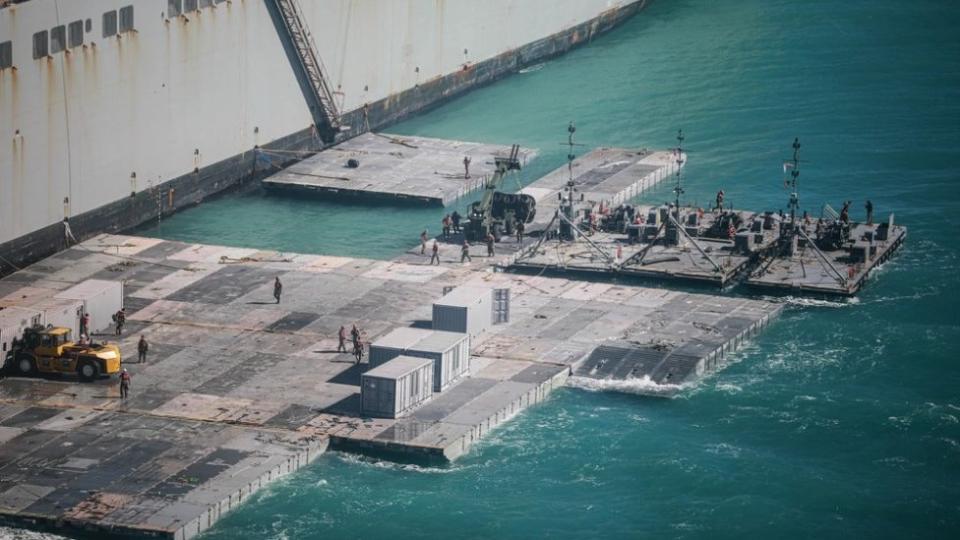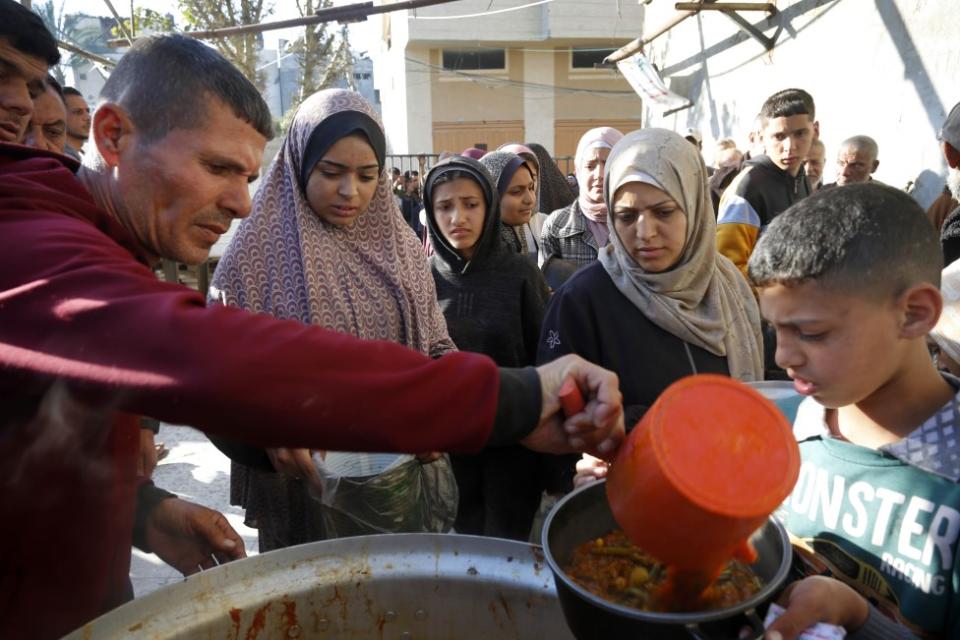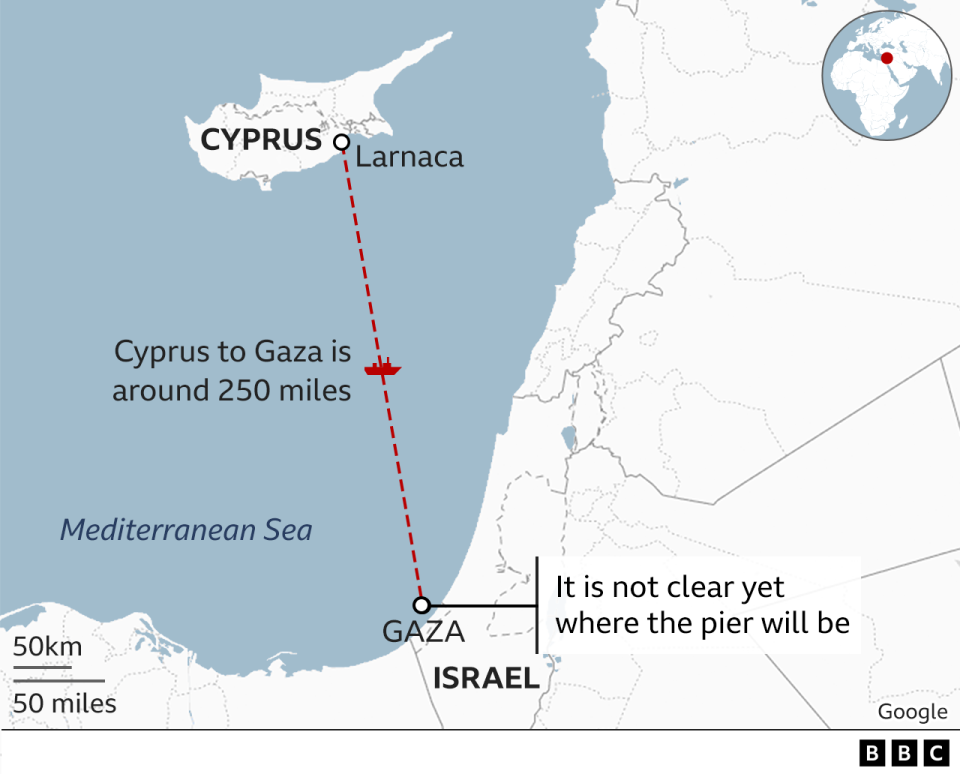How the US military plans to build a pier and deliver food to Gaza
A US plan to deliver aid to Gaza from a floating dock at sea will be fraught with potential logistical and security pitfalls.
More than 1,000 US troops are expected to take part in the operation, although the Pentagon says there will be no “troops on the ground”.
To achieve this, the United States partnered with a little-known private company, Fogbow, run by former military and intelligence officials.
The aim is to provide aid equivalent to two million meals a day in Gaza, where the United Nations has warned that famine is “almost inevitable” without urgent action.
Here is what we know about this immense logistical exercise.
How will the United States install the pier?
U.S. military ships set sail Saturday and Monday to deliver supplies to the Mediterranean. According to the Pentagon, the plan includes two main elements that must be assembled: a large floating dock made of steel segments and an 1,800-foot (548 m) two-lane roadway and pier.
The roadway will consist of 40-foot (12 m) interconnected pieces of steel tied together and attached to the shoreline.
Cargo ships deliver supplies to the dock and the aid is then unloaded onto a series of barges and smaller vessels – called logistics support vessels, or LSVs – and taken to the dock.
From there, vehicles will transport supplies to the mainland and to Gaza.
The causeway will be assembled at sea and “driven” down to the beach, allowing US forces to avoid setting foot on Gaza. The United States supports its ally Israel and has designated Hamas a terrorist organization.
This amphibious construction project – officially known as Joint Logistics Over-the-Shore, or JLOTS – is one that the US military has already used in Kuwait, Somalia, Haiti and Central America for missions of disaster relief.
Earlier versions were used as early as World War II, following the D-Day invasion of Normandy. As recently as July last year, the Ministry of Defense used similar JLOTS equipment during a large-scale exercise in Australia.
“The army’s preference, of course, is to have an operational port. It makes everything a lot easier,” Mark Cancian, a retired US Marine Corps colonel with experience in planning amphibious operations.
“But this is not always possible, whether due to a conflict situation or as part of a peacetime humanitarian mission,” he added. “That’s where JLOTS comes in.”
What is Fogbow and what role will it play?
Fogbow is led by Sam Mundy, a former Marine Corps lieutenant general who previously commanded forces in the Middle East, and Mick Mulroy, a former CIA paramilitary officer and assistant secretary of defense for the Middle East.
The full details of what they will do have not been made public before. But a person close to the plan told the BBC that Operation Fogbow – known internally as Plan Blue Beach – is mainly aimed at organizing the movement of aid after it arrives on the Gaza coast.
The containers will be emptied and their contents put on trucks for transport to distribution points further afield in Gaza, under a plan approved by the US and Israeli governments.

The BBC has been told that Fogbow is still seeking funding and has informed several European and Middle Eastern governments of his plans. Longer term, Fogbow plans to create a donor-run foundation to help channel aid to Gaza.
How will security be managed?
Military experts say the plan’s success depends on security, both from the possibility of hostile fire in a still-active combat zone and from large crowds of civilians gathering on the shore.
Retired Rear Adm. Mark Montgomery, a 32-year U.S. Navy veteran with experience providing humanitarian assistance, said the operation requires establishing a “safety cocoon” both on the beach and in the shallow waters nearby.
“You can’t let civilians go on the pier,” Mr. Montgomery said. “It could be parents desperate for food for their children – or they could be trying to kill someone. That would shut down operations.”
Two people close to the project told the BBC that the Israel Defense Forces (IDF) would provide “external” security to prevent crowds of civilians from reaching the beach and to secure the area. Distribution will be the responsibility of unarmed local Palestinians.

Fogbow is expected to have only a limited logistical role and will not be involved in distribution.
Although the Pentagon has said no U.S. troops will set foot in Gaza, experts say the reality may be more complicated.
“People are going to have to advise on the exact angles you want things to go at, or maybe the right consistency of sand needed, that sort of thing,” Mr Montgomery said.
“They’ll have to be there to check things out and make sure we’re anchoring in exactly the right place.”
If that person on the beach is not a U.S. military member, he or she will be an experienced contractor, likely a retired U.S. military member, Montgomery said.
What difference will shipments make?
According to the US Department of Defense, this temporary pier will allow two million meals per day to enter Gaza.
This would be enough to feed almost all of the territory’s 2.3 million inhabitants. It would also represent far more aid than currently arrives by land via the Rafah border crossing with Egypt and the Kerem Shalom border crossing with Israel, or through airdrops.
Earlier this week, State Department spokesman Matthew Miller said the maritime option was being considered because other options were insufficient. But he said there was no substitute for trucking aid over land, so they would continue to push for it.

The fastest and most efficient way to deliver aid to Gaza is by road. But aid agencies say Israeli restrictions mean a fraction of what is needed makes it through the crossing.
Aid organizations and U.S. officials have said increasing overland shipments remains the only viable option to meet demand while the pier is built.
“Even in the best-case scenario, (the pier) won’t be here for almost two months as an effective delivery mechanism,” Mr. Montgomery said. “We must take this into account as we face the humanitarian challenges over the next 45 days.”
The operation could operate in part before the construction of the pier. The BBC understands Fogbow is planning to dredge a beach to allow barges to get close enough to shore so aid can be offloaded onto trucks.
Others are also exploring the sea route for help while very little aid arrives by land.
A Spanish ship towing a barge loaded with 200 tonnes of food finally set sail from Cyprus on Monday. He hopes to dock at a small pier built by an American charity on the Gaza coast.
